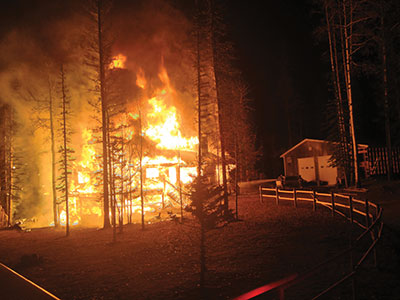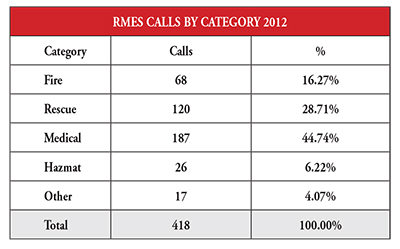
Features
Hot topics
Incident reports
Incident Report: January 2014
On Thursday, Oct. 24, at 7:18 p.m., Redwood Meadows Emergency Services (RMES) was called out to a report of a house fire southwest of Bragg Creek, Alta., where June flooding had decimated a large portion of the hamlet.
January 7, 2014
By Rob Evans
On Thursday, Oct. 24, at 7:18 p.m., Redwood Meadows Emergency Services (RMES) was called out to a report of a house fire southwest of Bragg Creek, Alta., where June flooding had decimated a large portion of the hamlet.
 |
|
| When Redwood Meadows Emergency Services arrived at the scene of this house fire near Bragg Creek, Alta., it was immediately determined that the operation would be defensive. Photo by Rob Evans
|
The description of the location placed the house in the response area of the neighbouring Priddis’ fire station but crews from RMES did not delay the response as they continued to the scene. Priddis is part of the Municipal District of Foothills Fire Department (FFD) and its crew were confirmed as responding with Engine 6 and Tender 6.
During RMES’ response, dispatch consistently updated RMES Engine 120 that multiple calls were now reporting the home on fire. Dispatched by Calgary’s Public Safety Communications, RMES is station 120 in the area dispatch plan. While still en route to the fire – an eight-minute response – a glow in the sky was quite apparent to the RMES crew and, in addition to the Priddis station response, Engine 120 re-quested the Heritage Pointe station from Foothills to respond with Engine 9 and Tender 9.
Still a couple of minutes away from the fire, the Engine 120 crew began to determine what each member on the truck would be tasked with upon arrival. As the truck arrived on scene, it was determined right away that the operation would be defensive.
Contractors on scene reported that nobody was in the home. Engine 120 pulled up the narrow driveway to the home and stretched a 44-millimetre (mm) line to protect an exposure of a workshop on the Alpha/Delta (A/D) corner.
The fire had travelled throughout the home and heavy fire was pushing out of the Bravo side, with heavy smoke pushing out of the eaves around the entire structure. By the time the line was stretched, heavy fire was blowing out all of the windows and the entire roof had self-ventilated. It was now necessary to reposition the engine, which was backed about 30 metres down the driveway. The line was quickly charged and crews got to work protecting the workshop exposure. They were also able to turn off the natural gas line into the house at the meter before fire took hold of the A/D corner.
Engine 120, a 5,000-litres-per-minute pumper with a 5,000-litre booster tank, had enough water and was used with Class-A foam to protect the workshop and a nearby forest with a second 44 mm line that had been pulled. Crews were able to save the workshop as well as a minivan on the A/D side; just a small number of trees in the forest exposure on the Charlie side were lost before the second line was deployed.
Within 10 minutes of Engine 120’s arrival, Engine 6 and Tender 6 had arrived on scene. Capt. Luc LeBlanc from Engine 6 reported to Engine 120 for an update. Given a report of actions taken so far, LeBlanc was asked to complete a 360 of the structure. Once complete, command was transferred to LeBlanc. Engine 9 and Tender 9 had arrived and it was decided to start putting water on the fire building, as there was now a supply of water. The water tender from RMES, Tender 120, had arrived on scene also. With more than 40,000 litres of water available, crews made short work of what was left of the fire building.
RMES responds to fewer than a dozen structure fire calls each year. Most structure fire responses for RMES are small and are handled quickly. The last structure fire of this magnitude occurred in January 2012 when a local gas station caught fire.
At the height of this house fire, three engines, three water tenders and two brush trucks with approximately 20 firefighters were on scene to tackle the blaze. Tenders had to travel back and forth from Redwood Meadows, a round trip of 24 kilometres, to fill up because of the remote location of the property. More than 10 people have been left homeless but, thankfully, nobody was injured. The cause of the fire was still under investigation at press time.
 |
Lessons learned
- Although RMES had radios that could communicate with incoming Foothills crews, there is still a need for more radio interoperability. Communication always seems to be an area in which operations can improve regardless of the size and scope of the incident.
- Although we all know each other and work very well together, it was recognized that both departments can do better with joint training, particularly with tanker-shuttle and rural water-supply operations.
Redwood Meadows Emergency Services
- 1 station
- 37 members (almost 100 per cent have some type of medical training)
- 2 engines, 1 tender, 1 rescue, 2 brush trucks, 1 rescue support trailer that carries a Polaris Ranger 6×6 utility transport vehicle
- Services an area of more than 1,000 square kilometres that includes the Townsite of Redwood Meadows, Tsuu T’ina First Nation, Rocky View County and Kananaskis Improvement District
- Population of more than 6,500 people, increasing during the summer to more than 12,000 at times
Rob Evans is the chief fire officer for Redwood Meadows Emergency Services, 25 kilometres west of Calgary. Evans attended the Southern Alberta Institute of Technology in 1989 and studied photojournalism. In 1992, he joined RMES after taking pictures of an interface fire and making prints for the department. He has his NFPA 1001 level II certification, NFPA 472 Operations and Awareness (hazmat), NFPA 1041 level I (fire service instructor), Dalhousie University Certificate in Fire Service Leadership and Certificate in Fire Service Administration and is a registered Emergency Medical Responder with the Alberta College of Paramedics. He lives in Redwood Meadows with his wife, a captain/EMT with RMES, and three children. Follow him on Twitter at
@redwoodwoof
Print this page